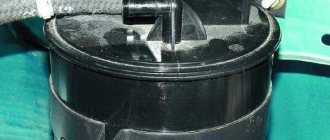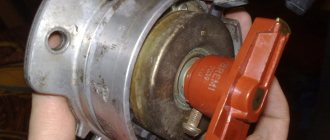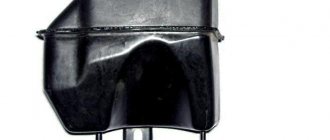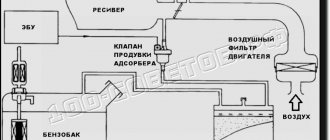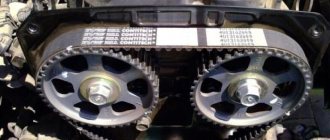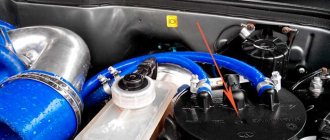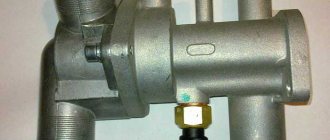In a car, the adsorber absorbs fuel vapor from the gas tank ventilation system and supplies it to the intake, because according to environmental standards, the gas tank must be isolated from the atmosphere.
From Wikipedia ;
Adsorber (from Latin ad - on, with and sorbeo - absorb) is a device for absorbing (thickening) a surface layer of a solid, called an adsorbent (absorber), of dissolved or gaseous substances, not accompanied by a chemical reaction. The adsorber is used in chemical, oil refining and other industries. The process occurring inside this apparatus is called adsorption.
Gasoline vapor filtration system. The diagram is quite conventional, but it reflects the essence. Gasoline vapor from the tank passes through a carbon filter, is cleaned and supplied to the inlet through a solenoid valve controlled by the ECU.
Now the first question is - why filter gasoline vapors if they still go into the intake? The answer is simple - adjusting the internal combustion engine control program by adding the nth number of clean air at the inlet is much easier than making adjustments based on the fuel-air mixture (gasoline vapor from the tank) of an unknown proportion.
And now the answer to the main question - why delete it? So, although some manufacturers claim that this device will have enough resources for the entire life of the car, we know that they are lying)
In general, over time, the adsorber becomes clogged and stops passing air. As a result, we get excess pressure in the tank, which interferes with the normal operation of the fuel pump. In the cabin (sometimes under the hood) we get a periodic smell of gasoline, the vapors of which are squeezed out of the ventilation tube. And the engine starts running on a rich mixture due to lack of air.
Now guess how our country solves this problem? That's right, most people simply throw out the adsorber and turn off the system as shown in the diagram:
A fuel filter from a carburetor classic is usually placed on the tube from the gas tank, and the solenoid valve, through which clean air should flow into the engine, is simply shut off with a bolt.
In the picture I already wrote that this is wrong and here’s why. This method of removing the adsorber only partially solves the problem. Yes, the smell of gasoline disappears, the tank is ventilated, but no air is supplied to the intake and the engine continues to run on a rich mixture.
And now the following diagram:
And now it already shows how it SHOULD be done. The same filter from the classics is put on the hose from the valve to the adsorber, which now serves as an air filter and prevents dirt from getting into the receiver. This is how the fuel-air mixture is brought to normal parameters.
Well, now a couple of visual photos of what it all really looks like:
Everything is clear here, one tube goes to the gas tank, the second through the valve to the engine.
Bottom part of the adsorber. There is a fitting for supplying air from the atmosphere so that a vacuum is not created in the adsorber.
So this is all done on my machine. I didn’t take a photo of the tube from the tank, it’s hard to get to it even without a phone
» How to remove
Lada 2110 PhiX › Logbook › Removing the adsorber on a VAZ 2110
Hi all! Today, I will tell you how to properly remove the adsorber on a VAZ 2110-12. First, a little background. It all started when one day I removed the locker from the rear left fender and saw frayed hoses clogged with dirt and some kind of container, which, as it turned out later, turned out to be a separator. Judging by the condition of the hoses, it was clear that the adsorber was not performing its function, but was just cracking the valve in vain. Even then, the first thoughts crept in about getting rid of this device. Recently, in connection with the transition to DBP, I had to switch to a sports engine management program, in which the adsorber is not involved. I still don’t understand whether the customizer considered it unnecessary to turn it on, or whether the firmware did not allow this, but one way or another, I decided to completely remove the adsorber from under the hood. The procedure for removing the adsorber is not complicated, but there are some aspects that you need to know.
What's the result?
Considering the above information, it is clear that the canister and the canister valve perform important functions. Moreover, system malfunctions can have a serious impact on engine performance. As a rule, the signs and symptoms of valve problems discussed above often indicate the need for in-depth diagnostics. In this case, the fuel vapor ventilation system is often the culprit.
We also recommend reading the article about what an adsorber is. From this article you will learn about why this device is needed, what functions it will perform, as well as what signs and symptoms indicate that the adsorber is faulty and needs to be checked, serviced or replaced.
For this reason, experienced specialists recommend regularly performing both computer diagnostics of the car and periodically performing mechanical checks (assessing valve performance, engine performance in different modes, etc.). This approach allows you to avoid unexpected breakdowns, as well as significantly increase the overall life of the internal combustion engine, gearbox, and other components, assemblies and systems of the vehicle.
How to check the adsorber valve. On our VAZs
- Posted by Avto-blogger
- Date: November 1 at 20:42
The specific question is #8212; how to check the operation of the adsorber valve? This device is found on many new cars. It is designed to absorb excess carbon gases from the car's gas tank. Thus, this mechanism prevents the release of gases into the atmosphere. It was necessary to use a device of this type after the introduction of new restrictive Euro-3 and higher standards. When working properly, the car has a low level of pollutant gases in the exhaust, and there is also a slight reduction in fuel consumption. However, like any device, this engine element also tends to break. Failure can occur due to clogging of the adsorbent inside the absorber, as well as due to direct mechanical impact on the absorber body. In any case, problems begin when the engine operates...
First, a little definition.
The adsorber valve - essentially stands on a can that has activated carbon inside, is actually installed in the gas tank (or nearby, maybe in the power system) and absorbs excess gasoline vapors. This “can” absorbs them, condenses them and sends them back to the power system. But for proper and long-term operation it needs to be ventilated.
And now in more detail
How can I check the functionality of this device? An important element in the absorber is the valve. To understand the function, let's look at how the adsorber works. When the car is parked, a large amount of gasoline vapor can accumulate in its tank. Some of the vapor is caught by the recuperator, and the rest settles back into the tank. The part that was caught is sent to the adsorber. When the engine is running, the absorber valve closes and interrupts the access of vapors, now they are sent into the combustion chamber. Why is this necessary? When you start the car, our device prevents vapors from entering the exhaust manifold, thereby reducing the amount of harmful substances in the gas.
How to identify a problem at work?
The most common symptoms of malfunction include:
1) Sometimes the engine starts to run unstable at idle speed;
2) If clogged, you may feel a slight increase in fuel consumption;
3) The car engine does not start the first time when hot;
4) A noticeable loss of traction at low speeds. At higher speeds, the loss of torque is less sensitive.
Another common malfunction is the appearance of cracks in rubber plugs. Through these cracks (holes), additional air is sucked in, and as a result, leads to problems with the engine.
Possible malfunctions in the operation of the device
The VAZ 2114 absorber, due to its intended purpose, is susceptible to clogging and at some point may become faulty. Problems are not easily determined and often only by secondary symptoms, for example, increased pressure in the fuel tank. It’s just that gasoline vapors, due to wear of the separator, remain locked in the space of the tank and begin to put pressure on its walls. An increase in pressure can be detected when unscrewing the tank cap - a characteristic hissing sound is heard.
Sometimes the gas tank cap simply shoots out of the neck, which means that the pressure has reached a critical level and the adsorber must be urgently changed. If there is a problem with the adsorber, the engine speed begins to jump up and down. Many car owners write on forums that you can remove the VAZ absorber and not suffer. But everything is not so simple, and there are never unnecessary parts in cars.
Removing the absorber alone is not enough; you need to think about what to do with gasoline vapors that have nowhere to be discharged, and that the ECU may also have to be reconfigured. After all, some types of on-board engine processors find a malfunction in the purging of the fuel system and put the engine into emergency mode, in which it will not be possible to drive normally.
As for malfunctions, the problem area of this adsorbent system is the purge valve. You can repair it yourself. All you need is a flathead screwdriver, but be careful when removing it. The problem is the valve fastening; often it is not metal, but plastic; it is not difficult to break. The mount is located on the engine cover. There are also clamps on the valve itself, which also require a careful approach. We remove them and take out the problematic part.
If you blow into the valve and air comes out of it, this means a 100% malfunction. A normal part will not allow air to pass through. If there is a problem with the valve, the car experiences problems when starting the engine hot, and gasoline consumption increases. If the problem is not corrected, there will be a Check Engine and loss of normal driving dynamics. Failure of the adsorber seal and failure of the purge valve can cause unstable engine operation at idle until it stops.
So, let's move on to valve repair. In its upper part there is an adjusting screw fixed with epoxy resin. Screw the screw in until it stops, counting the turns so that if something happens, you can return the canister valve to its original position. You can drop a little carburetor flushing fluid into the valve fittings. Then we blow it in the open position with compressed air. The repairs are done.
The valve can also wear out due to heat near the radiator, and there is nothing you can do to help it. The quality of the material from which the adsorber valve is made is not the best. The only solution can be to replace or change the location to a cooler one, for example, closer to the adsorber itself.
And now in more detail
How can I check the functionality of this device? The fundamental element in the absorber is the valve. To understand the function, let’s look at how the adsorber works. When a car is parked, a huge amount of gasoline vapor can accumulate in its tank. Some of the vapor is caught by the recuperator, and the rest settles back into the tank. The part that was caught goes into the adsorber. When the engine is running, the absorber valve closes and interrupts the access of vapors, now they are sent to the combustion chamber. What is it for? When you start the car, our device prevents vapors from entering the exhaust manifold, thereby reducing the amount of harmful substances in the gas.
Removal Features
The VAZ absorber is sometimes removed completely. To do this, you need:
- replace the gas tank cap with a leaky one;
- plug the supply and discharge pipes;
- often change the ECU firmware.
As mentioned above, you should not approach the adsorber as an unnecessary thing, and if you decide to remove it, remove it correctly so that the gas tank remains ventilated and not tightly sealed, as if there is an adsorber. Those who convert a carburetor engine to an injection engine have an advantage. If they do not touch the tank pipes, they do not disturb the carburetor ventilation system of the tank, so they do not need an adsorber.
What is an adsorber for?
Before moving on to the question of how to check the operation of the adsorber, let us briefly describe the operation of the gasoline vapor recovery system (in English called Evaporative Emission Control - EVAP). This will give a clearer picture of the functions of both the adsorber and its valve. So, as the name implies, the EVAP system is designed to capture gasoline vapors and prevent them from entering the surrounding air unburned. Vapors are formed in the fuel tank when gasoline is heated (most often during long-term parking under the scorching sun in the warm season) or when atmospheric pressure decreases (very rarely).
The task of the fuel vapor recovery system is to return these same vapors to the engine intake manifold and burn them along with the air-fuel mixture. As a rule, such a system is installed on all modern gasoline engines in accordance with the Euro-3 environmental standard (adopted by the European Union in 1999).
The EVAP system consists of the following elements:
- carbon adsorber;
- adsorber purge solenoid valve;
- connecting pipelines.
There are also additional wiring harnesses leading from the electronic engine control unit (ECU) to the said valve. With their help, this device is controlled. As for the adsorber, it has three external connections:
- with the fuel tank (through this connection, the generated gasoline vapors directly enter the adsorber);
- with an intake manifold (it is used to purge the adsorber);
- with atmospheric air through the fuel filter or a separate valve at its inlet (provides the pressure drop necessary to purge the adsorber).
The adsorber is a kind of barrel (or similar vessel) that is filled with ground coal, in which gasoline vapors actually condense, after which they are sent to the car's power system as a result of purging. Long and proper operation of the adsorber is possible only with its regular and sufficient ventilation. Accordingly, checking the car adsorber is to check its integrity (since the body may rust) and the ability to condense gasoline vapors. Even older adsorbers pass the carbon contained in them through their system, which clogs both the system and their purge valve.
Checking the adsorber valve with a multimeter
The solenoid valve for purge the adsorber directly purges the system from gasoline vapors present in it. This is done by opening it upon command from the ECU, that is, the valve is an actuator. It is located in the pipeline between the adsorber and the intake manifold.
As for checking the adsorber valve, firstly, it is checked that it is not clogged with coal dust or other debris that can get into the fuel system when it is depressurized from the outside, as well as with coal from the adsorber. And secondly, its functionality is checked, that is, the ability to open and close on a command coming from the electronic engine control unit. Moreover, not only the presence of the commands themselves is checked, but also their meaning, which is expressed in the time during which the valve must be open or closed.
Do-it-yourself absorber valve replacement
If signs of malfunction are detected, the valve will need to be repaired or replaced. The adsorber valve is inexpensive and easy to replace. To dismantle you need to have a pair of Phillips screwdrivers and know where the canister purge valve is located. Operating procedure:
The markings on the old and new valves must match.
- Open the hood and find a cylindrical device - an adsorber.
- Remove the negative terminal from the battery.
- Disconnect the wire block by pressing the latch and pulling it towards you.
- Loosen the valve.
- Remove the fittings under the latch and disconnect the hoses.
- Remove the valve together with the bracket from the adsorber.
- The new valve is installed in the reverse order.
Thus, even such a small element as the adsorber valve performs important functions and its malfunction can seriously disrupt the operation of the entire engine. Therefore, it is important to monitor the condition of your car and carry out diagnostics on time.
The device of the absorbent element of the car
Externally, the absorber looks like an oblong metal can with two tubes. Through the first, the vapors to be treated are supplied inside, and through the second, condensate is removed. Inside the main body, which has a cylindrical shape and is divided inside by a steel separator into two unequal parts, an absorbent and an evaporator are located.
The separator covers ¾ of the internal diameter, allowing coolant to flow freely through the cylinder. The absorber includes a generator and a capacitor. To prevent their contact, they are separated by an inclined plate. The separator has one half - solid, the other - perforated.
This design allows the absorbent to condense and return if it evaporates. This allows you to maintain the absorbent volume. The settling drops of refrigerant maintain its stable pressure. Subsequently they burn out in the engine.
Types of absorbers used
The topic of environmental protection is relevant for our country. Everyone should do it, especially owners of cars with internal combustion engines. Tons of harmful substances released into the atmosphere every year do not make the world around us cleaner and better.
To improve the environmental situation, an EVAP system is installed on each vehicle, in which the absorber plays a central role. Classification depending on the type of absorbent component.
1. Fixed granular absorbent is used;
2. Mobile granular absorbent is used;
3. A fine-grained absorbent is used, with a constantly boiling bottom layer.
Most automakers use devices that have the first type of design, since it has been proven to be the most effective. Designs of the second and third types also capture spent fuel vapors.
Their main disadvantage is the possibility of absorbent particles entering the atmosphere with spent fuel vapors. Therefore, to maintain an effective operating condition, the volume of absorbent in models with mobile and boiling states requires regular checking. To do this, the absorber must be dismantled.
There are problems, but everything is whole
Having the above symptoms, and having checked the integrity of the hoses, we move on to the adsorber valve. How to check it?
1) First of all, disconnect the negative terminal from the battery;
2) Remove the absorber (in most cases it is located on the right side of the engine near the car’s air system);
3) Now turn off the electrical power to the valve itself;
4) Remove the hoses (inlet and outlet);
5) Then we try to blow air into the system through the valve (into the holes for the hoses);
6) If it is working, then when the power is removed from it, it will be blocked, i.e. You won't be able to blow it out;
7) Check further. We connect two wires from the battery to the power contacts on the valve. At the same time, you should hear an opening sound (click);
8) When connected to the source, we try to blow air into it. It should work without problems, if not, then it is closed;
9) Reset the power, if it closes again, then it is 100% working.
By checking the adsorber valve in this way, you can determine its performance at almost 100%. Of course, there may be nuances in which this will be more difficult, but the principle is the same everywhere. Thus, we have described in detail how to check this device.
If it is faulty, then you need to buy a new one - the cost is about 2000 rubles, so before you immediately change it, check it. If the problems lie in the operation of the electronic control unit, then this is a completely different story and everything becomes much more complicated.
Now a short video of a VAZ engine.
I’ll finish here, read our AUTOBLOG.
(
10 votes, average: 4.10 out of 5)
Similar news
Do-it-yourself windshield polishing. In different ways + pass.
Different compression in the cylinders. Why and what to do? Let's figure it out.
Source
Characteristics of the working absorber
Let's look at some characteristics that allow us to judge the performance of the absorber.
When not in operation, the pressure inside the housing must be equalized with atmospheric pressure.
To prevent the absorption of the absorbent during the passage of the refrigerant, the absorbent liquid must have a stable consistency.
To be able to control the refrigerant flow, it must have a constant temperature.
Both liquids must be mutually soluble.
A prerequisite is high-quality mixture formation between the evaporator and the refrigerant.
Both liquids used must be chemically resistant and completely safe.
External signs of malfunction
Before checking the adsorber purge valve, as well as the adsorber itself, it will certainly be useful to find out what external signs accompany this fact. There are a number of indirect signs, which, however, can be caused by other reasons. However, when identifying them, it makes sense to also check the operation of the EVAP system, as well as its constituent elements.
- Unstable engine operation at idle speed (the speed “floats” to the point where the car starts and stalls, because it runs on a lean air-fuel mixture).
- A slight increase in fuel consumption, especially when the engine is running “hot”, that is, in a warm state and/or in hot summer weather.
- It is difficult to start a car engine when it is hot; it is usually impossible to start it the first time. And at the same time, the starter and other elements associated with starting are in working condition.
- When the engine operates at low speeds, the loss of power is very noticeable. And at higher speeds there is also a decrease in torque.
In some cases, it is noted that if the normal operation of the gasoline vapor recovery system is disrupted, the smell of fuel may enter the cabin. This is especially true when the front windows are open and/or when the car is parked for a long time in a closed box or garage with poor ventilation. Also, poor operation of the system is caused by depressurization of the fuel system, the appearance of small cracks in fuel lines, plugs, and so on.
